Train Smarter
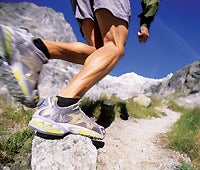
Intro: Get Strong for Summer | 60-Minute Gym Fix | Short on Time? | Strength | Cross Training | Cardio Power | Endurance
Get Strong for Summer
Developed in the mountains by backpackers for backpackers, our workout will prime your body for the best hiking season of your life.
Which hiker do you want to be: The switchback-gasping, hamstring-seizing slacker or the summit-tagging, all-day-striding workhorse? The gal who bails on the sunset sidehike, or the one who always pushes higher?
Easy choice, right? And easier said than done–until now. In search of a fitness plan that could whip us into shape fast, we tracked down Nate Goldberg, possibly the only guide in the United States who teaches hiking fitness for a living. An alpine instructor for two decades in the Alps and Rockies, Goldberg, 45, now directs the Summer Hiking Center at Colorado’s Beaver Creek Resort. “I’ve taken thousands of people into the mountains,” says Goldberg, “and the most elementary lesson I’ve learned is that there’s an undeniable relationship between fitness and fun on the trail: The fitter you are, the more fun you have. End of story.” We asked Goldberg to adapt a workout he shares with clients and create a preseason training plan for BACKPACKER readers looking to tackle tougher, higher trails. The result–a six-week program of strength, endurance, cross-training, and cardio exercises, plus bonus moves for overachievers–is the most hiking-specific program we’ve seen. Start right now, and we guarantee you’ll feel younger, stronger, and more agile by Memorial Day.
The Schedule
Monday
>> Rest
Tuesday
>> Strength/ Gym
Wednesday
>> Cardio
Thursday
>> Strength/ Gym
Friday
>> Cardio
Saturday
>> Long Endurance Hike
Sunday
>> Cross-Training
Intro: Get Strong for Summer | 60-Minute Gym Fix | Short on Time? | Strength | Cross Training | Cardio Power | Endurance
Intro: Get Strong for Summer | 60-Minute Gym Fix | Short on Time? | Strength | Cross Training | Cardio Power | Endurance
60-Minute Gym Fix
Work your whole system in just an hour.
- 5 minutes: warm up with jumping jacks, spinning, or light stretches
- 20 minutes: hit strength and core–think lunges, hamstring curls, chin-ups, dips, side crunches, planks, and any of the moves on the following pages
- 30 minutes: get your heart rate within 65% to 80% of max on a stairclimber, treadmill, or exercise bike–making sure to bump up the incline and resistance to mimic hills
- 5 minutes: cool down with easy stretching
Intro: Get Strong for Summer | 60-Minute Gym Fix | Short on Time? | Strength | Cross Training | Cardio Power | Endurance
Intro: Get Strong for Summer | 60-Minute Gym Fix | Short on Time? | Strength | Cross Training | Cardio Power | Endurance
Short on time?
No problem. Do what you can–and play it smart.
Maybe your big hike is only a month away. Or perhaps you’re tied up coaching Little League. If time is tight, don’t despair: Starting our program 10 days out from your dream trip is better than nothing. Just don’t kill yourself trying to cram six weeks of exercise into three, says Goldberg. “You’ll only exhaust yourself by the time you hit the trail, and set yourself up for a miserable vacation.” If you’d rather hit every part of the training plan in one day, try our 60-minute, all-encompassing compromise. And remember–you’ll have to scale back your ambitions in the backcountry and build in more rest days: Hike for two days, take a day off. Whatever you do, don’t skip the preseason training: Any amount you put in is going to help.
Intro: Get Strong for Summer | 60-Minute Gym Fix | Short on Time? | Strength | Cross Training | Cardio Power | Endurance
Intro: Get Strong for Summer | 60-Minute Gym Fix | Short on Time? | Strength | Cross Training | Cardio Power | Endurance
Strength
Build muscle by mimicking on-trail challenges in the gym.
Since a trail is rarely flat or free of debris, it’s pointless to train your muscles to work only as if they’re going to propel you along in a straight line. In this workout, Goldberg incorporates plyometric exercises to shore up the connective tissue in your joints, develop the neural pathways that improve balance and agility, and build explosive muscle that you can tap to scramble over a boulder or check a slide down a muddy embankment.
Start with a 10-minute warm-up walking or running on a treadmill set on a steep incline (20% or higher), or do some easy hill repeats or stadium steps. Complete all of the sets for each exercise before moving on to another. This ensures that you fully exhaust your muscles and reap maximum gains.
Radial lunges
Start with a deep forward lunge with your right foot and then come back to standing. Continue lunging with the same foot as if you were stepping on the numbers of a clock face, facing forward the entire time. Work your way around until you’re in a reverse lunge with your right foot in the 6 o’clock position. Repeat with your left foot and work your way clockwise from 6 o’clock around to 12 o’clock. Slowly lower yourself into each lunge, then quickly spring–but don’t jump–back up to standing. Do 4 sets.
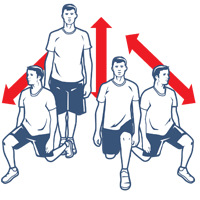
Why they work Lunges heighten your sense of balance as they build your quads and glutes. “By working your way around a circle, you develop your body’s ability to handle diagonal and lateral steps,” says Goldberg. “That’s the kind you’d face on a steep and tricky switchback.”
Accelerate it Alternate speed lunges, working your way around the circle as quickly as you can without losing control, with weighted lunges, where you hold 10 pound. dumbbells in each hand. Reverse directions with each set (i.e. work clockwise in the first set, counterclockwise in the next).
One-Legged Calf Raises
Lay a 45-pound weight plate or a roughly 2-inch-thick board or platform on the ground. Stand on the edge on one leg. Lift yourself onto your toes and slowly lower yourself back down until your heel rests on the floor. Repeat. For more intensity, hold a dumbbell in one hand (as much as you can manage while holding your body straight). Do 25 reps on each side. Repeat 4 times.
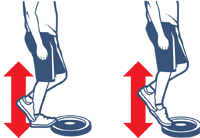
Why they work “Take a look at the calves of a mountaineer. They’re huge,” says Goldberg. “That’s because mountain climbing taxes those muscles like no other activity.” Using a plate or board ensures that you get full range of movement in the exercise while reducing the chances of an over-extension injury from doing this exercise off a high step.
Accelerate it After you complete the calf raises, do a set of one-legged hops back-and-forth across an imaginary line on the floor. Complete 100 per leg. Not only will you feel the burn in your calves, you’ll also strengthen the connective tissue in your ankles and knees and reduce your chances of a sprain on the trail.
Hanging Hip Flexors
Hang from a chin-up bar with your legs dangling straight down. Bend your knees and lift them toward your chest while crossing your knees to your left side. Lower back down over a three count. Lift your knees again, this time crossing them toward your right side. Do 2 sets of 15.
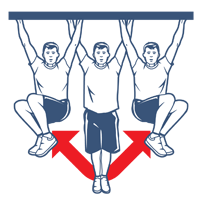
Why they work After six hours on the trail, you’d be surprised how much fatigue in your hip and lower stomach muscles can slow your walking pace. What’s happening: Your stride gets shorter as you tire, and you slow down. This move strengthens your hips, lower abdominals, and oblique muscles, keeping you on pace.
Accelerate It Hold a basketball (or harder yet, a medicine ball) between your knees. You’ll scorch your adductors and other smaller hip muscles during the drill–plus the added weight helps carve your abs.
Bicycle crunches
Lie on your back, hands behind your head, elbows wide. Lift your shoulders and twist your torso while you straighten the opposite leg. Keep toes flexed. Do 2 sets of 30.

Why they work According to a 2001 study conducted by the Biomechanics Lab at San Diego State University, the bicycle crunch remains the most effective abdominal exercise around. It hits your legs, upper and lower abs, and obliques quickly and in concert, giving you the hair-trigger support needed on steep, tricky downhills where good balance and torso control keep you upright.
Accelerate it Follow up with two sets of 20 old-fashioned sit-ups.
Bench Hops
Stand next to a bench-press station with the barbell set on the highest point of the rack. Grab the bar with arms shoulder-width apart, hands centered. Squat down and jump up onto the bench while keeping your hands on the barbell. As you jump, keep your head up and your abs engaged, and attempt a light landing on the bench. Pause, and then jump down to the other side. Reverse the sequence to complete one rep. Do 4 sets of 5 hops.
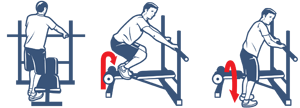
Why they work In addition to the quad strength you gain from the jump, the bent-over position activates your lower and upper back as you pull your legs over.
Accelerate it Jump completely over the bench in one motion and back again. Want even more? Nix the barbell, stand up straight, and jump from side to side over the bench.
Scissor Jacks
Start by doing one classic jumping jack. On the next hop, split your legs and opposite arms forward and back. Hop back to the start, do another regular jack, then repeat the forward/back leg split on the opposite side. Four jacks (two regular; two modified on either side) equals one rep. Do 2 sets of 25.
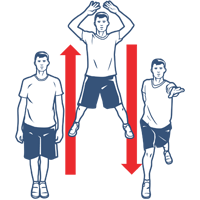
Why they work This mild cardio workout builds agility and explosive strength through a complex sequence of jumping that fine-tunes coordination. The more coordinated the body, the more efficiently it moves. Take it slow until you can do one set fluidly.
Accelerate it As your coordination improves, jump higher and faster to build cardio strength, and work your way up to 100 reps. Done that? Slow down and drop into a full lunge each time you step forward. It’ll add a strength and balance component.
Intro: Get Strong for Summer | 60-Minute Gym Fix | Short on Time? | Strength | Cross Training | Cardio Power | Endurance
Intro: Get Strong for Summer | 60-Minute Gym Fix | Short on Time? | Strength | Cross Training | Cardio Power | Endurance
Cross Training
Pick a sport–any sport–and enjoy this day of active rest.
Mountain biking An easy one-hour ride, especially if you spend time out of the saddle, engages your core and works your shoulders and chest, employing the same muscles you use when you climb with trekking poles.
Yoga Getting some mat time builds balance, core strength, and flexibility–and teaches you how to control your breathing, a skill that can make a long climb feel easier.
Running Go for a mellow jog on varied terrain. Aside from boosting cardio endurance, the uphills will work your calves and the downhills will strengthen your quads.
Spinning Hop on a spin bike and do intervals, alternating between high resistance (like climbing a steep trail) and low (easing up when the trail levels off).
Intro: Get Strong for Summer | 60-Minute Gym Fix | Short on Time? | Strength | Cross Training | Cardio Power | Endurance
Intro: Get Strong for Summer | 60-Minute Gym Fix | Short on Time? | Strength | Cross Training | Cardio Power | Endurance
Cardio Power
Build sprints into your program to increase overall speed.
Get out for a run or fast walk at a pace that allows you to hold a conversation. Start with 40 minutes and work up to an hour. Ten minutes into your run, find a long, steep hill or staircase (something that takes at least 30 seconds to ascend) and sprint up it. Power uphill six times, walking back down. Finish your workout with a five-minute cool down. According to The American College of Sports Medicine, intervals burn more fat and help keep it off better than steady plodding. More important, they increase your speed on the trail, which translates to more ground covered and new territory explored.
Intro: Get Strong for Summer | 60-Minute Gym Fix | Short on Time? | Strength | Cross Training | Cardio Power | Endurance
Intro: Get Strong for Summer | 60-Minute Gym Fix | Short on Time? | Strength | Cross Training | Cardio Power | Endurance
Endurance
Exercising with your pack on now makes hiking with it later feel like less of a workout.
On endurance days, you want to approximate the distance and loads that you’ll be carrying on your big trek. Use the same gear you would on the trip: boots, pack, trekking poles. Stuff your pack with 2-liter soda bottles filled with water; in addition to working your legs, you’ll prime your torso and shoulder muscles. As you hike, tap that water to stay hydrated, but don’t pour it out at the top of the climb.
Intro: Get Strong for Summer | 60-Minute Gym Fix | Short on Time? | Strength | Cross Training | Cardio Power | Endurance